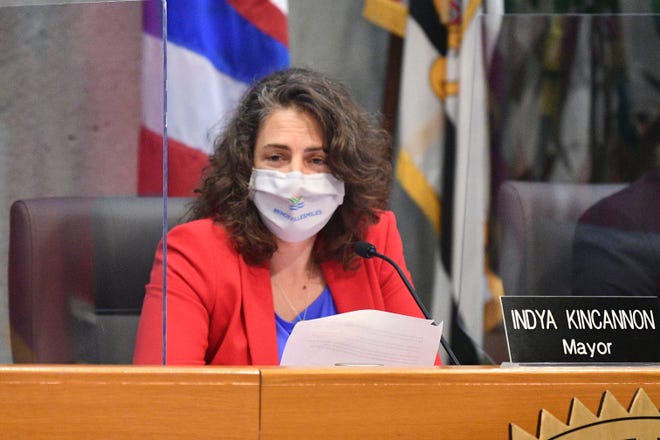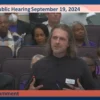By Tyler Whetstone, Knoxville News Sentinel
The Knoxville City Council approved Mayor Indya Kincannon’s second budget — her first from out of the shadow of COVID-19 — which supports affordable housing and increases funding for police by roughly 4.5%.
Both issues have become flash points in the community.
In all, the $384.2 million budget is about $49 million larger than last year’s as the city plays catch-up on maintenance projects that were excluded from last year’s “no frills” budget. The budget passed by the council Tuesday night was more in line with what Kincannon envisioned when she ran for office.
“I’m really proud of this budget,” she said after Tuesday’s vote. “We were able to do a lot of innovative things, some things that I’d been hoping to do last year (like) we’ve been able to move forward on affordable housing. The Affordable Housing Trust Fund is huge.”
That vision came to fruition with a promised $50 million over 10 years for housing, starting with $8.1 million in the upcoming fiscal year. The money will be used to support mixed-income residential developments.
The housing proposal is a way to meet basic needs. The percentage of Knoxville residents living in poverty is more than double the national rate, according to U.S. Census data. City estimates show that more than one in three households in Knoxville pays too much for housing, meaning they pay more than 30% of their income on rent, and housing costs have increased at a higher rate than incomes over the last several years.
Danny Johnson, a leader of Justice Knox, which worked with the mayor’s office to development the plan, said the money is a down payment because there is still much work to do.
Kincannon said Justice Knox has pushed for more to fix affordable housing but has been willing to come to the table to get this proposal across the finish line.
The affordable housing push is one of several ways the mayor’s office has intentionally addressed systemic inequalities. In the last six months, council members have approved legislation that apologizes and starts to make financial amends for decades of urban removal and sets aside $1 million for violence prevention work after multiple shooting deaths of Austin-East Magnet High School students.
Council members question police co-response program
The budget included $400,000 to quadruple the city’s co-response program, which pairs a social worker from the McNabb Center with a police officer for calls involving people experiencing mental health issues. The funding does not guarantee a contract because that must be approved separately.
The expansion will support teams on daytime and evening shifts, seven days a week. The program started as a test that cost $95,000 and only covered one officer working with one social worker some hours of the day. The program will now pair four officers with four social workers.
A handful of residents spoke against the co-response program, saying having an officer respond to a mental health crisis can make the situation worse.
Moria Conley said there’s no way for the city to know how many people in crisis aren’t calling 911 because they know a police officer will respond. She mentioned that Cities United — the company the city is paying implement violent reduction policies — often suggests a mental health policy that does not include police presence.
Parker asked council members to amend the budget, moving the $400,000 set aside for the program to a holding fund of sorts, but the amendment failed. She said council members are continuing to repeat the same conversation about officers responding to mental health crises and wanted the city to include the public in the discussion about public safety.
The mayor’s staff was asked to schedule a workshop to dig into the co-response and a model that doesn’t include police.
Tight budget gets attention
Knox News previously reported on a small conservative group’s effort that would, if successful, limit the city’s ability to raise property taxes in future years. While many obstacles remain for the group (their first step is Wednesday’s Knox County Election Commission meeting), their efforts have put a spotlight on the city’s budget.
Simply, the city’s costs have outpaced revenues. Like a family budget, they argue, dipping into the savings account is not sustainable in the long term. This budget is requiring the city to draw $12.9 million from its savings account, which is called a fund balance. The city’s fund balance currently totals about $87 million.
In the future, sustaining a similar budget will require more development to generate additional tax revenue, increased tax rates or spending cuts.
A protest on the process
As she did on the first reading of the budget, Parker voted against the budget out of principle because the council’s hands are tied when it comes to approving it. She asked for more time to go through items, both major and minor tweaks, but was rebuffed.
As Law Director Charles Swanson explained two weeks ago, the city’s charter requires two readings of the budget. On second reading, line items can only be amended if funds are taken from one area and given to another in equal amounts. Had council not approved the vote on second reading Tuesday, it would still be approved within 15 days, per the city charter.
Parker said the culture of the council makes it feel disrespectful to propose an amendment to the budget. A budget line hasn’t been changed during the process since the 1980s, Swanson previously said.
Masks rules change
Tuesday’s meeting was the first meeting since the pandemic began where Kincannon and council members didn’t wear masks — only Councilperson Amelia Parker kept hers on throughout the meeting. During the meeting, the mayor tweeted the end of the city’s policy requiring masks inside public buildings.
“My new executive order says all persons entering a building or indoor space owned, managed, operated or leased by city of Knoxville shall wear a face mask consistent w/ CDC guidance,” she tweeted. “With new guidance out last week, anyone fully vaccinated is not required to wear a face mask.”
View the original story here.






